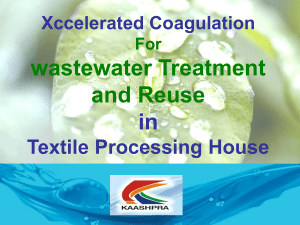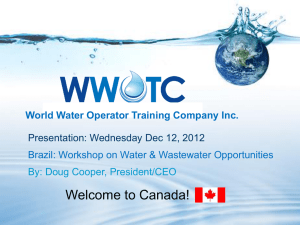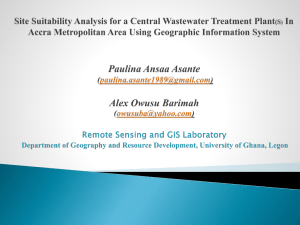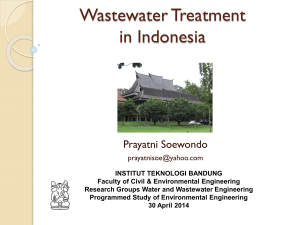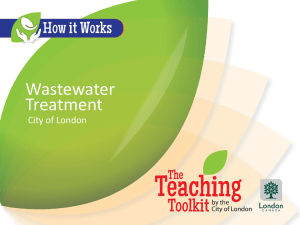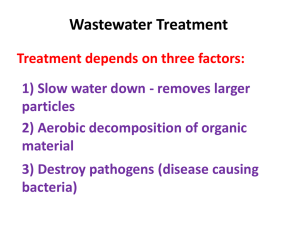prgs-biogranules-proposal-presentation-1
advertisement
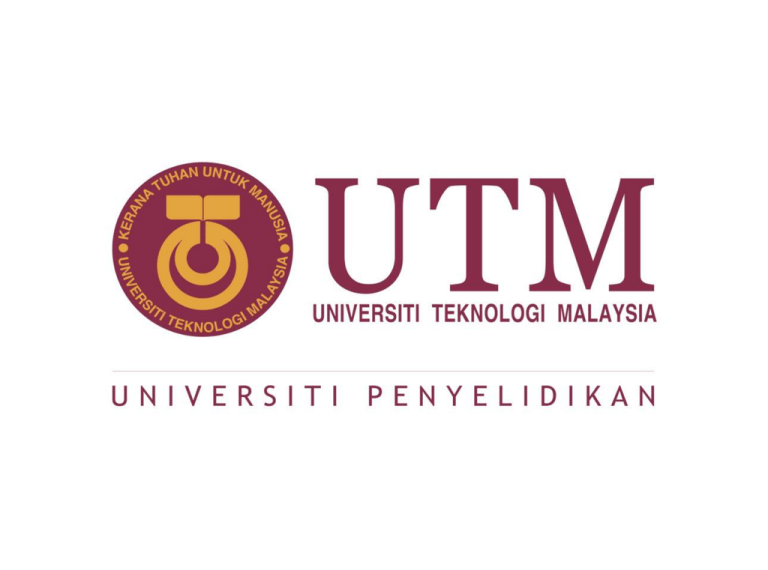
Treatment of Textile Wastewater using Hybrid Biogranular System Contact: Assoc. Prof. Dr. Azmi Aris / Dr. Khalida Muda Department of Environmental Engineering Faculty of Civil Engineering Universiti Teknologi Malaysia The Problem Highly colored wastewater from textile industry High concentration of non-biodegradable organics, suspended solids, conductivity, turbidity and intense color 10% of the chemical in textile processing will remain on the fabric….. 90% will be discharged in textile effluent (IPPC, 2003) 80 -100 m3 of textile wastewater are generated per ton fabric (Savin et al, 2008) Conventional biological system fails to treat textile wastewater Physico-chemical treatment is available but expensive in terms of chemical and operational costs Environmental Regulations (Industrial Effluent), 2009 Colour* Std A – 100 ADMI Std B – 200 ADMI *Color was not regulated in previous regulation Our Solution Hybrid Biogranular System Features Treat textile wastewater within relatively short period of time Simple yet reliable and proven effective (90% COD and color removal) Use microorganisms rather than chemicals – no chemical sludge, environmentally sustainable INSPIRING CREATIVE AND INNOVATIVE MINDS Basis of Technology Anaerobic followed by Aerobic stage INSPIRING CREATIVE AND INNOVATIVE MINDS Use biogranules instead of bioflocs - higher biomass concentration and shorter sedimentation time Biogranules function in both anaerobic and aerobic Hybrid - requires only one reactor – small foot-print Excess biogranules (sludge) - stored or sold to other treatment plant - potential source of income INSPIRING CREATIVE AND INNOVATIVE MINDS WHAT IS BIOGRANULES Biogranules » Developed in the reactor under » » » » specific conditions Irregular shape with smooth surface Size of 2.3 + 1 mm in diameter as compared to 0.02 + 0.01 for flocs Dense and compact with excellent settling property (approx. 80 m/hr) Structurally strong INSPIRING CREATIVE AND INNOVATIVE MINDS Single reactor in sequencing batch-mode feed anaerobic (9 hr) aerobic (3 hr) anaerobic (9 hr) aerobic (3 hr) settling (5 min) Treatment can be completed within 24 hours ACHIEVEMENT Hybrid Biogranules System for Textile Wastewater Treatment Development of Anaerobic Granules Containing New Specialised Dye Degrading Microbes for Raw Textile Dyeing Wastewater Treatment. Funded by MOSTI (Vot # 79137). RM 220,000 (2007 – 10) Biochemical Reduction of Azo Dyes from Textile Dyeing Wastewater using Facultative Granular Sludge. Funded by MOHE (Vot # 78211). RM 100,000 (2007 – 09) Publications (Peer-reviewed) Muda, K., Aris, A., Salim, M.R., Ibrahim, Z., van Loosdrecht, M.C.M., Ahmad, A., Nawahwi, M.Z. (2011) The Effect of Hydraulic Retention Time on Granular Sludge Biomass in Treating Textile Wastewater, Water Research, 45, No. 16, pp 4711-4721, 2011 (IF: 4.546). Muda, K., Aris, A., Salim, M.R., Ibrahim, Z., Yahya, A., van Loosdrecht, M.C.M., Ahmad, A., Nawahwi, M.Z. (2010) Development of Granular Sludge for Textile Wastewater Treatment, Water Research, 44, 43414350. (IF:4.355) Ibrahim, Z., Amin, M.F.M., Yahya, A., Aris, A., Muda, K. (2010) Characteristics of the Developed Granules Containing Selected Decolourising Bacteria for the Degradation of Textile Wastewater, Water Science Technology, 61, 1279-1288. (IF:1.09) Publications (Conference Articles) Muda, K., Aris, A., Salim, R.M., Ibrahim, Z. (2010). Biogranulation Treatment Technology for Textile Wastewater. ITS-UTM International Conference 2010 on Sustainable Urban Environment. 8-10 Dec 2010, Rectorat Building, ITS, Surabaya, Indonesia. Muda, K., Aris, A., Salim, R.M., Ibrahim, Z., Yahya, A., Ahmad, A. and Nawahwi, Z. (2010). Granular Sludge as Compact Treatment System for Textile Wastewater Treatment. 1st IWA MALAYSIA Young Water Professionals Conference. 2–4 March 2010, Best Western Premier Seri Pacific Hotel, Kuala Lumpur. Amin, M.F.M., Ibrahim, Z., Yahya, A., Aris, A. and Muda, K. Potential Application of Developed Granules Containing Decolourising Bacteria for Treatment of Raw Textile Wastewater, 30th Symposium of Malaysian Society for Microbiology – Microbes: Biotechnology Engine for Health and Wealth Creation, Kuantan, 1619th August 2008. Awards Gold Medal at Seoul International Invention Fair (SIIF) 2011 in Seoul, Korea. Gold Medal at 10th Malaysia Technology Expo (MTE) 2011. Green Technology of the Year Award at 10th Malaysia Technology Expo (MTE) 2011. Silver Medal at 12th at Industrial Art & Technology Exhibition (INATEX), Universiti Teknologi Malaysia, 2010. INSPIRING CREATIVE AND INNOVATIVE MINDS Patent Pending A Process for Treating Wastewater (PI 2009 2162) Bacteria Granules for Treating Wastewater (PI 2009 2163) INSPIRING CREATIVE AND INNOVATIVE MINDS Market Opportunity Overall Market China Industry with colored wastewater Oil Palm Food (500) Indonesia Municipal Landfill Thailand Market Initial Market Segment Textile Industry (100 +++) VCLM Research Team DR. KHALIDA MUDA PROF. DR. RAZMAN AP. DR. AZMI ARIS (FACULTY OF CIVIL ENGINEERING) AP. DR. ZAHARAH DR. ADIBAH YAHYA (FACULTY OF BIOSCIENCE AND BIOENGINEERING) INSPIRING CREATIVE AND INNOVATIVE MINDS Prototype Development Research Grant Scheme Treatment of Textile Wastewater using Hybrid Biogranular System Objectives 1. To design and fabricate a prototype hybrid biogranule system for treating textile wastewater 2. To further enhance the characteristics of the biogranules developed in the bioreactor taking into consideration the size of the prototype plant 3. To evaluate the performance of the system in terms of pollutants removal under different textile wastewater pollutant loads and characteristics Objectives (cont.) 4. To optimize of the system through manipulation of operating parameters i.e. total hydraulic retention time, anaerobic and aerobic reaction times, solids retention time, and superficial air velocity of the system 5. To determine the biokinetics behavior of the process and to evaluate the toxicity of the byproducts of the degradation INSPIRING CREATIVE AND INNOVATIVE MINDS Layout Hybrid Biogranule System pump inlet to SBR Activated Carbon Holding tank from mill’s sump (1 m3) SBR Column discharge to river pump (1 m3) Sand Filter data logger and control system sludge outlet pump control automation network discharge to river Research Methodology Framework Planning Research Activity 2012 A S O 2013 N D J F M A M J J 2014 A S O N D J F M A M J J 1.Literature Survey 2. Design and Fabrication of Hybrid Biogranule System 3. Biogranules development and enhancement of biogranules characteristics ○ Characterization of microbial granular sludge -Physical, chemical &biological characterizations -Identification the microbial biodiversity X X 4. Initial performance evaluation of the stable system (COD, BOD, color, TSS, TDS, TN, TP) 5. Optimization of the operational paramaters ○ Variation of HRT, SRT X X ○ Variation of superficial air velocity - Removal performance efficiency (COD, BOD, TOC, color, etc) - Energy consumption 6.Investigation of the biokinetics behavior and byproducts toxicity (OUR, X SOUR, µ, kd, Yobs, Y and SMA) 7. Data Analysis X 8. Report Writing Technology Transfer Activities Attending workshop/ seminar/ conferences ♦ ♦ Budget Budget Details Year 1 (RM) Year 2 (RM) Total (RM) Salary and wages (V11000) 24,000 24,000 48,000 Travelling and transport (V21000) 12,500 17,500 30,000 Rental (V24000) 15,000 15,000 30,000 Research materials & supplies (V27000) 83,500 58,500 142,000 Maintenance and Minor repair services (V28000) 15,000 15,000 30,000 Professional services (V29000) - 20,000 20,000 Accessories and equipment (V35000) 200,000 - 200,000 TOTAL 350,000 150,000 500,000 Thank You


